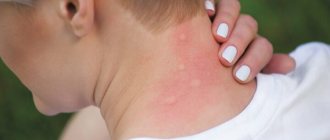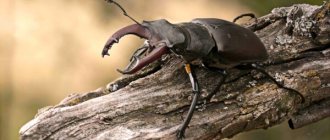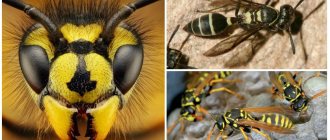During the long cold and dark days of winter we look forward to summer - sun, warmth, flowers and greenery. But when it finally comes, we are prevented from enjoying it fully by various “biting” insects - mosquitoes, midges, wasps, bees, ticks. And it would be okay if the whole thing came down to only minor inconveniences - itching and redness at the site of the bite. But in some cases, the consequences of insect attacks can be much more serious. Along with redness, swelling, itching, an allergic reaction to the poison may also develop. And for some, this can result in anaphylactic shock and, if measures are not taken in a timely manner, even death. Children are especially susceptible to insect bites.
Even the most ordinary mosquitoes, which only make an adult wince in annoyance, can cause great harm to a baby. In order to minimize “losses” from flying and crawling “enemies,” you must be able to promptly provide yourself and those around you with first aid for insect bites.
Mosquitoes
Let's start with the most common mosquitoes - if in the city mosquito nets and repellers can help get rid of annoying buzzing insects, then in nature it is almost impossible to get rid of miniature bloodsuckers. They are especially annoying near water, in shady places and with the arrival of cool twilight.
Females sting mosquitoes - they pierce the skin with a thin long proboscis and suck the blood from the capillary. The consequences of a mosquito bite are also known to almost everyone; this is redness and a swollen blister that itches for a long time - the degree of reaction is usually individual.
But the bites of these insects are not as harmless as they seem! There are 10 species of malarial mosquitoes in Russia (mainly in Siberia, but also found in the European part), and ordinary mosquitoes are quite capable of transmitting all sorts of infections, from encephalitis to yellow fever. Moreover, according to statistics, approximately 5-10% of mosquitoes in our latitudes are infected with some kind of disease.
A strong aqueous solution of baking soda will help relieve swelling and itching from a mosquito bite; any available substance with menthol in the composition (for example, toothpaste) can also help - they just need to be spread on the bite site or, after soaking a handkerchief, make a mini-compress. You can also wipe the bite site with a weak vinegar solution (vinegar: water = 1:10) or apply ice wrapped in a cloth.
Among the folk remedies for relieving itching and swelling, we will name mashed leaves of plantain, cabbage or mint, as well as slices of raw potatoes or parsley decoction.
- 8 plants that repel mosquitoes
These plants repel mosquitoes no worse than chemical repellents!
Midges
This collective name hides a mass of tiny (up to 2-3 mm long) stinging dipterous insects that externally resemble miniature flies. Like mosquitoes, it is the females who “hunt” people - they need blood and lymph as a source of protein for laying eggs.
Most often, midges are found near flowing bodies of water or in places where garbage accumulates. Their activity zone is daytime, low windy weather at temperatures of 8-30°C.
Oddly enough, the consequences of a bite from this little thing are much more serious than a mosquito bite - the swelling is greater, lasts much longer and hurts more. This is due to the fact that when attacked, the midge literally chews the tissue and injects poisonous saliva, causing bleeding and swelling.
Alas, midges are also often carriers of dangerous diseases, helminth eggs, and viral infections. Enzymes from midge saliva, injected into the wound during a bite, can cause a severe allergic reaction - simulidotoxicosis, accompanied by a sharp rise in temperature, chills, headaches, and inflammation of the lymph nodes.
You can protect yourself from the abundance of midges by using tight-fitting clothing and a hat with a mosquito net (mosquito net) impregnated with repellent. In case of a bite, treat it with ammonia, any alcohol infusion, iodine or brilliant green to reduce itching. The remaining measures for a midge bite are similar to those described above for a mosquito bite.
If an allergic reaction develops, you need to take an antihistamine tablet and consult a doctor immediately.
Tarantula Hawk: 4.0
0
The Tarantula Hawk is a fierce wasp that feeds on tarantulas. This is one of the most dangerous insects that you probably don't want to encounter. This wasp has a bluish-black body with brightly colored wings, although there are varieties with black and blue wings. Tarantula hawks have long legs with hooked hooks at the end, which helps them grab their prey tightly and sting them with one of the most painful stings in the world. The Schmidt Index describes the tarantula hawk's sting as disgustingly electric, brutal and blinding. The bite can cause anyone to roll on the floor screaming in pain. The bite pain index is 4.0 points.
Burner flies
No, this is not the familiar housefly, but its relative, which lives “in the wild” and feeds on the blood of warm-blooded animals, yes, including humans. The number of insects increases towards the end of summer - beginning of autumn, which is why they are also called autumn flies.
You can meet these flies everywhere in the countryside; they are synanthropes, human companions. They breed mainly in places where there are large domestic animals, laying eggs in manure or rotting plant debris.
Both males and females “bite” the fly - by rubbing the proboscis against the skin, the fly scrapes off the epidermis and, feeding on blood, simultaneously lets in poisonous saliva, causing severe irritation. Externally, the site of the bite on the skin differs little from that of a mosquito. In addition to causing painful itching, flies are mechanical carriers of staphylococcus, as well as the causative agents of anthrax, sepsis, tularemia and other diseases.
In addition to flies, wolfhart flies are also dangerous in Russia, which can lay eggs under human skin, subsequently causing myiasis.
Measures for a bite are still the same - relieving itching and swelling with the help of improvised means, an antihistamine in case of an allergic reaction, consulting a doctor in a severe case.
Means for preventing fly bites are also similar to those described above - protective clothing, mosquito nets, and the use of repellents.
Red Reaper Ant: 3.0
0
The red harvester ant provides a great service to farmers as it eats many pests. These ants have a nearly square head with a relatively long body without a spine, and their reddish-orange color distinguishes them from other ant species. The positive thing is that they attack rather reluctantly, although they do have a painful sting. Schmidt describes the sting from these ants as bold and relentless, and the bite feels like drilling out an ingrown toenail. According to the pain index, the pain of a red harvester ant bite is 3.0.
Horseflies and gadflies
Horsefly on the left, gadfly on the right
If we're talking about biting flies, we can't help but mention horse flies and gadflies. Yes, these insects are biologically also flies, albeit very large ones, sometimes up to 3 cm in length.
There are more than 150 species of each of these insects, so accurately describing their appearance is not so easy. Gadflies are usually lighter in color, “short” and “fluffy”, while horseflies are darker and have a more elongated and flattened body, as well as huge eyes.
In terms of bites, horseflies are much more dangerous for humans, whose mature females require the blood of warm-blooded animals and are very active during daylight hours. Horseflies fly very quickly and can actively attack people, especially in the hottest part of the day and when the skin is moistened with water or sweat - during swimming, physical work in the air, or simply when being near bodies of water. It is also believed that these insects (like gadflies) are attracted to bright and dark colors in clothing, movement and perfumes.
Horsefly bites are very painful. Saliva containing anticoagulants and toxins is released into the injection site. Toxic substances in saliva lead to redness and painful swelling of the skin. Anticoagulants prevent blood clotting and cause prolonged bleeding from wounds that do not heal for a long time. In addition, horseflies are carriers of a number of helminths, viruses (including tick-borne encephalitis) and bacteria.
The overwhelming majority of gadflies are not blood-sucking, but are parasites of large animals - a person can suffer from these insects only if the eggs of the gadfly somehow get on his mucous membrane or under the skin. But if a female gadfly decides to pierce your skin to lay larvae, you will notice this by large swelling and redness.
What to do if you are bitten by a horsefly or gadfly? As in previous cases, wash the bite site with soap and running water, cool, and relieve itching and swelling using available means. If allergic reactions occur, use antihistamines, and in case of complications (fever, weakness, headache, diarrhea, etc.) consult a doctor.
Insects with a sting. Who will bite harder?
Who scares people the most? Of course, insects with a sting. Who of these “cuties” bites the most is our today’s top.
Is there a person on Earth who has not been bitten by some insect at least once? It is unlikely! Such “attention” from biting creatures is not only unpleasant for us, but simply painfully hateful! Have you ever wondered who bites the most? Did you know that once a scientist named Justin Schmidt even created a pain threshold scale for insect bites? If not, then here is our “rating” of the most harmful cockroach insects to humans. Look at their photos and remember them “by sight”, so that in case of an unexpected meeting with them, you will be, as they say, fully prepared!
Postal wasp
Postal wasp
If it is unbearably hot outside, or you are simply doing physical labor in the lap of nature, then be prepared to become a victim of the postal wasp. This winged nipper is attracted precisely by the salt contained in human sweat. When this insect stings, a sharp pain immediately occurs, as if you were struck by an electric current. According to Professor Schmidt's scale, such a bite scores one point. Not too much, right? But it hurts a lot!
Fire Ant
Fire ant
The next insects that we would not really like to meet are fire ants. Although they don’t fly like wasps and bees, their sting is oh so unpleasant! First, these six-legged creatures bite a person, then inject acid. With the help of their sting, these insects introduce into the victim’s body, that is, our toxic poison, called solenopsin. When this ant bites, it feels like you've been burned by an open flame. And this is far from your little finger hitting the doorframe! Apparently, this is why these creatures received the prefix to the name “fiery”. In some cases, if a person is sensitive to a toxic substance, such a bite can be fatal! We give them 1.2 points on the Schmidt scale.
Wasp Dolichovespula (Dolichovespula)
Dolichovespula wasp
Even more “cruel” among insects are wasps belonging to the genus Dolichovespula. These are representatives of the family of true wasps. These insects are black in color, with two or three transverse stripes. When such a wasp bites, a strong stabbing sensation occurs. The pain scale rates these “biters” at 1.8 points.
Bee
A bee, but not a harmless one.
Bees... well, how can we do without them in this “rating”? To get a dose of bee venom under your skin, you don’t have to be an avid beekeeper; you just need to go into a flowering garden where these “toilers” collect nectar. If you accidentally decide to interrupt the work activity of this flyer or drive her away from her “place of work,” you may earn a painful “slap in the face” from her. When a bee stings, a strong burning sensation immediately appears on the skin and then it becomes oh, how painful! For example, an Italian bee sting is rated at 2 points on the pain scale.
Reaper Ant
Reaper Ant
And again - ants. This time the role of the “aggressor” is the red American harvester ant. This insect is from the stinging order. Therefore, as you already understand, there is no need to expect leniency from him - he will gladly use his sting to show “who is boss here”! An ant stings much more painfully than a bee and a hornet. If you convert it into points on the Schmidt scale, you get about 3!
Paper wasp
Paper wasp
Another animal that stings at three points is paper wasps. You'll immediately know you've been bitten by a paper wasp because your skin will start to burn as if acid had been poured on it! So, hitting the corner of the table with your elbow and hitting the nerve is a pleasant tickle!
Wasp Repsis (Pepsis)
Pepsis wasp
But the Pepsis wasp is even capable of exerting a paralytic effect at the site of the bite. The pain is sharp, acute. This is unlikely to be confused with anything. In comparison, a mosquito does not bite, but simply gently tickles the skin! We give this wasp 4 points - she rightfully deserves them!
Ant Paraponera Clavata
Ant Paraponera Clavata
And the ant Paraponera Clavata closes this “competitive ranking”. It has such a powerful sting and toxic venom that the pain from the bite continues to bother you for a day after the attack. This representative of the ant “kingdom” was nicknamed the “bullet ant”, apparently for the lightning-fast and strong “blow” with its sting, with pain much stronger than the young man’s acquaintance with the bicycle frame when falling! It ranks highest on the pain scale – 4.0+ points!
Now you will definitely be more attentive when brushing off annoying, stinging creatures on the street, because you have learned how dangerous they can be!
If you find an error, please select a piece of text and press Ctrl+Enter.
Fleas
Small wingless fleas are blood-sucking insects. There are many species of them, they are found everywhere, feeding on the blood of humans, as well as animals and birds. So if you have chickens, rabbits, a guard dog, mice in the underground, a cat walking on its own comes to visit, or squirrels at the feeding trough, then fleas are also present.
Flea bites appear as red itchy spots with a dot in the center - usually there are several spots, because... The insect does not limit itself to a one-time bite and drinks blood “in reserve.” You will definitely notice the painful moment of piercing the skin, but you are unlikely to grab a tiny, fast-jumping insect to figure out whether it belongs to one species or another.
How can a flea bite be dangerous? It usually goes away on its own within a couple of days, but there can be complications. These insects can cause two diseases in humans: pulicosis and sarcopsillosis. Plus a possible allergic reaction. In addition, fleas are carriers of many dangerous infections and can be intermediate hosts of some parasitic worms, such as nematodes.
What to do if bitten by fleas? In the same way, first of all, relieve swelling and itching, as we described above. If allergic reactions occur, it is necessary to use drugs with antihistamine components, and in case of complications (fever, weakness, headache, diarrhea, etc.) consult a doctor.
Prevention measures include treating pets with insecticidal preparations (shampoos, tablets, etc.).
Differences from a bee sting
It was mentioned above that the wasp’s sting is smooth. As for the bee, its sting is not even, it has teeth, so the bee cannot take the sting back from the body after stinging. When flying away, the bee leaves the sting along with part of the stomach, that is, the back part of its body is simply torn off, and the sting acts almost like a winch. It is very dangerous when such an action occurs, because the detached abdomen continues to contract, sending new portions of poison into the wound. To prevent this from happening, immediately after an insect bite, you need to try to remove the sting. Meanwhile, the bee, left without half its body, quickly dies.
The wasp sting, due to its structure, cannot catch on soft tissue, so the wasp takes it with it. The exception is cases when the predator was killed directly during the bite - then the poisonous component of the insect remains in the body, which can threaten allergic reactions in the future.








